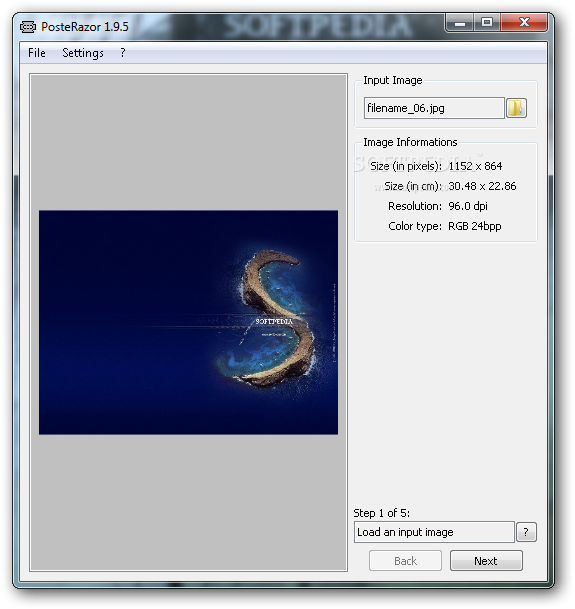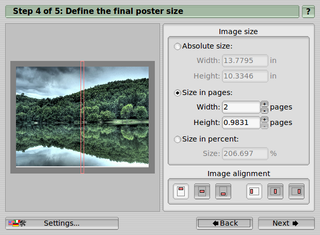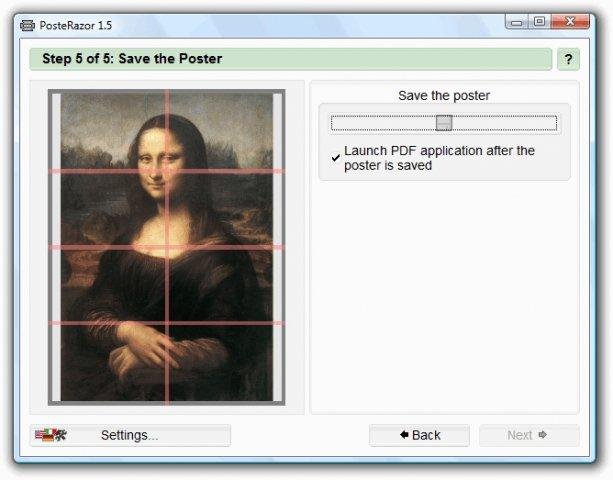

- #Posterazor software mac os x#
- #Posterazor software pdf#
- #Posterazor software upgrade#
- #Posterazor software full#
- #Posterazor software free#
#Posterazor software free#
The free version only lets you look at them, while all the layers and editing tools sit behind a paywall. Sadly, you won’t be able to do any advanced editing as in Photoshop and other alternatives. Your mouse and keyboard give you access to scrolling, and you can quickly print with the touch of a few buttons. You can rotate images around if they are upside down or at the wrong angle. There are a few other tools available if you’re using the free version. It has a drag-and-drop functionality that makes it straightforward to open them, or you can browse.
#Posterazor software upgrade#
Once you’ve linked the account, you can easily view your images and upgrade your membership at any time. It will ask you for your email address, which you’ll need to verify afterwards.
#Posterazor software mac os x#
PosteRazor 1.5 requires Mac OS X 10.3.9 or later.To use ACDSee Free, you need an account.
#Posterazor software pdf#
Finally, the developer notes the following missing features: Cut lines/aids Support of Jpeg-CMYK images Support of 16 Bit Grayscale images Embedding an ICC profile into the PDF if there is one embedded in the input image I also wish PosteRazor provided an option to print a faint border around your image, so that if your image is smaller than the assembled poster-in other words, if there’s a blank area all the way around-you could neatly trim off the extra paper even if the image background is the same color as the paper. What don’t I like about it? As a cross-platform program, PosteRazor’s interface looks very much like that of an older Unix or Windows program. PosteRazor is simple to use and works well. You can also choose the language used: English, German, French, Italian, Dutch, Spanish, or Portugese. PosteRazor’s preferences window lets you choose your preferred units of dimensions: meter, millimeter, centimeter, inches, feet, or points. If your final image-your poster-is smaller than your “grid” of paper pieces, you can also choose whether to center the poster on the pages or align it against any edge.

(Keep in mind here that the quality of your final poster is limited by the resolution of your original image a low-res image won’t look good at very-large sizes.) If you choose either of the first two options, PosteRazor lets you designate a height or width and then automatically adjusts the width or height, respectively, to keep the original image’s proportions.

PosteRazor lets you choose an absolute size, where you designate the final width and height a size in terms of the number of pieces of paper required to print the poster or a size as a percentage of the original image. In the next step, Step 4, you choose how large you want your poster to be. A preview shows you, in red, the area of each page that will overlap with adjoining pages. In Step 3, you choose how much of each page’s portion of the image should overlap with those of the adjoining pages-in order to make aligning the pages into a single, larger image easier-and on which edges that overlap should occur. Not that most people in PosteRazor’s target market will have a printer that can print on 16-foot paper.) You can also designate non-printable borders if your printer can’t print all the way to the edge. (According to the developer, the size limit for each page is five meters, which is actually a limit of the PDF format. Choices include A3, A4, legal, letter, and tabloid, or you can enter custom dimensions. Step 2 is where you choose the size of the paper onto which you’ll be printing. PosteRazor can also load 32-bit RGBA images, but transforms them to 24-bit RGB. Supported color types include monochrome, grayscale, 4-bit, 8-bit, 24-bit RGB, 48-bit RGB (for TIFF and PNG), and 32-bit CMYK (for TIFF). Halo, GIF, ICO, IFF, JBIG, JPEG/JIF, KOALA, LBM, Kodak PhotoCD, PCX, PBM, PGM, PNG, PPM, PhotoShop PSD, Sun RAS, TARGA, TIFF, WBMP, XBM, and XPM. PosteRazor supports a wide range of image formats: BMP, DDS, Dr. In the first step, you use choose the image file you want to work with. PosteRazor uses a clear, five-step process to produce your poster. Doing exactly this is the purpose of Alessandro Portale’s PosteRazor 1.5 ( free).
#Posterazor software full#
Wide-format printer (or don’t want to pay for the use of one at your local print shop)? One solution is to print the image in smaller sections, each taking up a sheet of standard paper, and then put those sections together to create the full image. Have you ever wanted to print a high-resolution image at a very large size-say, the size of a poster-but you don’t have a


 0 kommentar(er)
0 kommentar(er)
